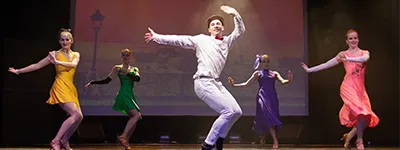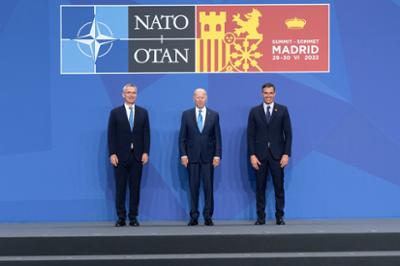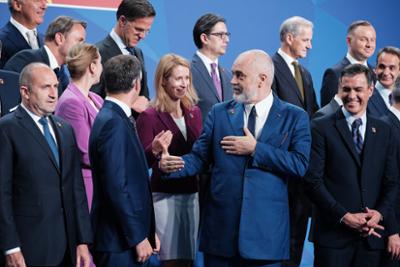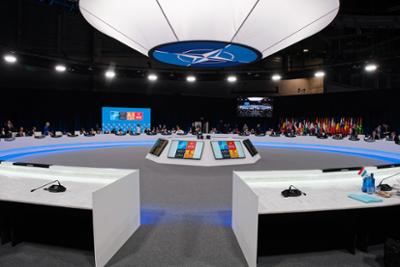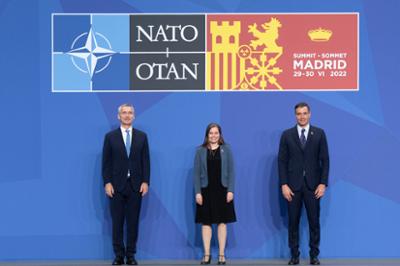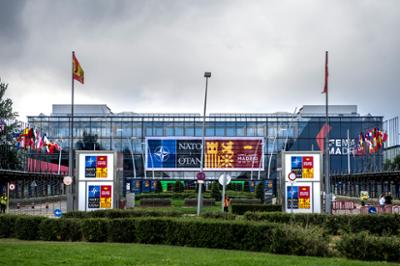
The great challenges (that you didn’t know about) of the NATO Summit.
We will never forget the NATO Summit at IFEMA MADRID, the international event of great magnitude which transformed Madrid into the centre of the world for 48 hours, offering an image of absolute organisational ability. As in the COP25, IFEMA MADRID took charge of all the project management along with its partners and providers (such as PRG and Servis), this time with more preparation time (7 months, 20 days of assembly) but with great challenges, some of them stemming from the current circumstances, such as the scarcity of resources. The organisation of the summit reminded us of the importance of collaboration (even more with so many parties involved), as well as the capacity for last minute responses and flexibility. Were there last minute changes? What were the greatest challenges and learning curves after such an enormous international event?
Firstly, who is who?
The event, as such, belongs to the NATO, but when a country hosts it, the government assumes responsibility for it. In Spain’s case, it was decided that the event would be organised from the Presidency of the Government, and a Coordination Unit was set up within Moncloa. This unit took charge of the organisation and global coordination, meaning that it acted as an intermediary between the NATO and each of the multiple actors under it. You can probably image how many people were involved in holding an event of this magnitude... let’s say that the coordination unit was just the tip of the iceberg.
All this is explained to us by Ana Carrazón, the Project Manager who led the project on behalf of IFEMA MADRID, and who had a direct relationship with the Coordination Unit (and also some contact with NATO) and who filtered the information needs and distributed them to the different areas of IFEMA MADRID. She informs us that she was the only person in direct contact with the Coordination Unit, apart from the area of telecommunications and cybersecurity which, given its importance, also maintained direct contact.
The challenge of creating and designing the project without too much specificity
One might think that, for an event like this, you would work with a very clear briefing with all the details... but no: there were only generic guidelines on the table. “The unique feature of the event, which made its coordination and organisation more complex, is that the requirements were not absolutely set in stone”, Carlos Jiménez, director of operations tells us, who coordinated everything related to telecommunications, systems, and the technical aspects of the event.
As with COP25, IFEMA MADRID and its ecosystem of partners and suppliers (such as PRG and Servis) had to design the entire project: layout, planimetry, construction... They oriented the way to respond to the demands of an event of these characteristics, given the very open nature of the specifications of needs. The design was first approved on a national level with the Coordination unit; they made a series of changes and, step by step, it was approved with the client.
Very demanding technical requirements
Despite these general specifications and the freedom when it came to designing the project, certain features were very well defined by the client: features such as soundproofing, light intensity and temperature. The PRG and Servis partnership were entrusted with meeting this challenge in the face of demanding technical requirements. “We were supported by our own production team (PRG and Servis) and other external engineers who helped us to find the best solutions”, these providers tell us.
Guaranteeing cybersecurity and resources
Whether we wanted it or not, this summit took place in precarious circumstances, with an international conflict in the heart of Europe. Today, the context of cybersecurity and also the supply of materials and equipment is much more complicated than it was at the time of COP25. This lack of resources was felt and “resources had to be guaranteed as soon as possible (wood, flooring…), even before we had a final draft of the design, otherwise not all the material would have arrived.”, Ana Carrazón tells us.
IFEMA MADRID was not the only venue where cybersecurity had to be taken care of, but as it was the venue with the largest number of installed services requiring this supervision, great responsibility and challenges in this area fell on its shoulders. In this way, it was the actor that coordinated its private cybersecurity providers in its facilities and ensured communication with the IT unit of the Presidency of the Government and the State Security Forces responsible for the cybersecurity of the entire Summit. Many public bodies supported this work in cybersecurity and once again, teamwork is what stands out.
Historic telecommunications and production rollout
In addition to the complexities related to Cybersecurity, the summit was the event with the greatest concentration of telecommunication services held at IFEMA MADRID that wasn’t a trade fair. Imagine 2,600 network connections, with 86 kilometres of cable, and more than half of the 2,600 located in a very specific area. This density of services, added to the use that was going to be made of the points concentrated in the Media Centre workstations, plus the streaming of the Press Conference Rooms, led IFEMA MADRID to have to reinforce the bandwidth designated exclusively for the event and to do so with more than one provider.
Also, as PRG and Servis explained to us, sustainability was also a feature of the production. For example, modular solutions with the ability for reuse were employed. “Also, on a logistical level, more than 90% of everything used was of local origin and close to the location, non-local items were of an exceptional nature, such as the two 30 metre circular trusses, of which there are very few in the world”.
In terms of corporate responsibility, IFEMA MADRID donated to food banks more than 700 kilos of excess food from the restaurant services provided by EUREST Servicios Ferials. In addition, 8 lemon trees and 6 olive trees, from among the more than 100 trees and plants that decorated the Summit, were given to the Presidency of the Government to be planted in the Moncloa gardens, as an environmental legacy of the Summit. As another permanent reminder of the summit, the reproductions of two paintings from the Reina Sofia which decorated the leaders’ area were also given to the Presidency and now hang on the walls in the Moncloa Complex.
General security ws the responsibility of National Police
The coordination of security at such an event , in general terms, falls to the National Police. IFEMA MADRID did not assume this responsibility, nor that of the protection of the authorities, but as they explain to us, the organisation of an event of this type disrupts all the daily dynamics of how the venue manages security. “The security and self-protection plan for the space was completely resized (partly due to the assembly itself, and partly to accommodate certain requirements such as cybersecurity or the protection of the authorities), fire brigades, doctors, etc…”.
The last minute and new needs
There were not many significant or dramatic changes, but… “in the last month the NATO did refine the details, for example: what type of screens and where, and what content should be displayed. These types of details were important for providers such as PRG, RTVE and Overon, we knew about them with less margin than we anticipated”, explained Ana Carrazón.
At the last moment, although they tell us they already suspected it, there was a need to block mobile phone coverage in some areas of the event. Some of the 5G operators, a technology used for the first time at an event at IFEMA MADRID, had to remove this technology and leave only 4G. Similarly, in Pavilion 12 there could be no mobile coverage or Wi-Fi, but at the same time very close to the pavilion it was necessary for some of the delegations to use it. According to Carlos Jiménez, extreme control of the wireless connection was achieved. “We had to ensure that in one space there was no signal and in another very close by there was, and that is complicated. With the mobile phone operators, thanks to the contacts we have, we were able to calibrate the signal in real time at each moment and in each place.”.
The keys to this project
Collaboration and teamwork. According to IFEMA MADRID, the key to the success of the event was to create a team "with people we trust, with our ecosystem of partners". PRG and Servis agree that, before the summit, with many complex decisions to be made, they worked as a team towards the same goal.
Communication and trust with the client. Ana Carrazón highlights IFEMA MADRID's relationship with the Coordination Unit (remember, the tip of the iceberg). “We have been very close, with open communication which has made everything flow easily and created an atmosphere of trust.”.
Capacity for response and flexibility. As well as the details specified to IFEMA MADRID at the last minute, as PRG and Servis told us: “The agenda changed daily, it was necessary to have the capacity for last minute responses and to be flexible in face of these changes in agenda: of people who were going to appear, suddenly there are six at the same time and not two...".
Get ahead and create up to plan Z. Taking note of possible situations that could happen and putting many layers of protection in place in advance in case something went wrong. For example: the connection for a video conference with Zelenski, the president of Ukraine, which was considered to be a key moment, had three backups.
Also, the ability to detect needs, and according to Ana and Carlos: “To do things without anyone asking for them, nobody asked us to provide more walkie-talkies, we detected that they might be needed, so we obtained them".
In the end, despite the context of scarce resources and the pandemic, the coordination efforts during those 7 months, added to the proactivity of plans A, B and C, made it possible for IFEMA MADRID to deliver to the Presidency of the Government and NATO, 5 days before the Summit, a project that was a true reflection of everything that had been promised, offered and worked on. A set-up that the Secretary General of the NATO rated as “a perfect, impeccable and excellent organisation... in facilities where everything was available”





